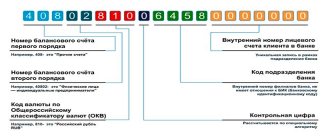For the timely formation of the status and amount of debt to third-party companies, the accounting records of the purchasing company must contain operational information about how much was transferred from the current account to suppliers. This information is reflected and accumulated to account 60.
Refund of funds from the current account.
Is it allowed to transfer money from current accounts to cards?
Both individuals and legal entities can transfer money from bank accounts. When registering with a bank, one or more accounts are opened for any client. Some accounts are used for savings, others for payments with your own money or using borrowed funds from the bank. When applying for loans or credit cards, loan accounts are opened for the client.
Bank cards are linked to different types of accounts, which is why they issue standard, savings and credit cards. Current accounts linked to a standard debit or savings card may be the same or may differ. Please note that installment cards are a variation of a credit card that differs only in terms of service, and not in the process of use.
Both individuals, individual entrepreneurs and companies can send money from their current account to cards to individuals. Payment orders for transfer can be issued:
- from a bank specialist - for all categories of clients;
- in the payment terminal – for private clients, individual entrepreneurs and corporate card holders;
- on the Sberbank Online website for private clients or through the Sberbank Business Online system for legal entities.
If you create a payment order template, you can send money using the details at any time and with minimal time.
It is important to draw attention to the fact that all owners of plastic cards have current accounts that are linked to this card. This may not seem obvious to some users who have little experience or have just started working with the bank. From these accounts, clients can make not only payments using a plastic card, but also non-cash transactions without the participation of plastic. Bank non-cash payments are made from the sender's account directly using the recipient's details or his card number.
Analytical accounting of calculations
Account 60 contains complete information about the facts of economic activity, while the capabilities of accounting programs provide for the provision of analytical accounting of calculations - in the context of counterparties, contracts or invoices for payment.
Analytical accounting allows you to generate complete information for each supplier for a given period of time and contains the following information: name of the counterparty, list of concluded contracts, opening balance, turnover for the period under study, final balance, amount of debt, documents of the basis of business transactions.
The results of analytical accounting are widely used in management accounting for the prompt settlement of emerging debts, for meeting delivery and payment deadlines, in the process of forming a payment calendar and cash flow budget for departments and organizations.
Crediting the advance to the supplier
The terms of concluded contracts may provide for the transfer of an advance payment (prepayment) for products supplied, work performed or services provided. In this case, in the accounting records of the organization, it is necessary to reflect the advance transferred from the bank account in a separate subaccount 60.2 by accounting entry:
By debit 60.2 By credit 51 - prepayment under the agreement (invoice) is transferred.
Repaying debt from a current account
Payment of debts to counterparties for materials, work or goods that have already been received by the organization is most often carried out in non-cash form from the current account of the organization - the debtor. The servicing bank is sent a payment order for the transfer of funds indicating the details of the recipient and his bank, as well as the purpose of the payment, disclosing the information on the basis of which the debt arose.
When the bank executes an order to transfer funds, the amount of debt is reduced by this amount. The grounds for repaying a debt to a creditor under a payment order from an organization’s current account may be: the terms of the concluded agreement, an invoice, an invoice, a delivery note, a reconciliation report.
How to record transactions in the cash book
Payment to suppliers can be made in cash. In this case, an expense cash order is issued reflecting the amount of cash disbursed, the last name, first name, patronymic and passport details of the cash recipient, a document confirming the granted authority to receive cash.
The operation of repaying accounts payable is reflected in the cash book in the expense column with the following accounting entry:
By debit 60.1 By credit 50.1 - issued from the cash desk to repay the debt to the supplier (company name) through... (last name, first name, patronymic of the authorized person).
If the payment exceeds the cost of the goods supplied, work performed or services rendered, the operation of receipt of the excess money paid to the supplier into the cash register is formalized by a cash receipt order and reflected in the cash book in the receipts column with the following accounting entry:
Features of sending money from current accounts of legal entities
Legal entities and entrepreneurs, in principle, cannot operate without a current account. Their main transactions are carried out by bank transfer. Companies can make transfers to individuals, individual entrepreneurs, government agencies, LLCs or enterprises of other forms of ownership.
Transfers between individuals do not attract as much attention as payments between individual entrepreneurs and legal entities. Interest in the movement of funds through the accounts of private clients will arise only if the operations are classified as dubious or the individual is suspected of money laundering.
Banks and tax authorities monitor operations of transferring money to cards to individuals carried out by individual entrepreneurs or legal entities much more carefully. Therefore, it is very important for entrepreneurs and companies to indicate the exact purpose of the transfer in the purpose of the payment:
- When paying wages to employees, you need to formulate it this way - “Salary” or “Advance”. You should also write for which month the transfer takes place.
- When paying for services under the contract, enter the wording from which this will become clear. You can also add what services or goods you are paying for, as well as the number of the agreement with the counterparty.
- If an individual entrepreneur transfers money as a gift to a relative or friend, indicate “Transfer of personal funds.”
Transfers from the same bank arrive day after day. A transfer to another bank can take from 1 to 3 days.
How to transfer money to an individual’s card from an individual entrepreneur’s current account
To transfer money from an individual entrepreneur to an individual’s card, you need to log in to the website and select the “Payments and transfers” item. An additional menu will open, where you need to go to the “Payment to the counterparty” tab. Be sure to indicate that the payment is not subject to VAT if it is a transfer to your card or a gift. A form for filling out a payment order will appear on the screen. Indicate in it:
- sender details;
- current date;
- document type and payment order number;
- the account from which money should be debited;
- amount to transfer.
In the designated field, indicate the recipient of the amount of money. In the list, you can select an individual to whom you have already sent money before. If this is a new counterparty, add it to the list of other recipients. To do this, fill out information about the recipient in a special form and click “+” next to the field. All entered data will remain in the system. If you want to send money to the same recipient again, you can select him from the list of saved ones. All information about the counterparty will be filled in automatically.
To sign a payment order, an SMS code will be sent to the phone number authorized in the Sber database. Enter the resulting set of numbers in a separate field. Before completing the operation, check that the entered data is correct. After this, click “Send to Bank”. When the specialist checks and confirms the payment, the money will be debited from the individual entrepreneur’s account and sent to the recipient.
How to send money from a legal entity account
Legal entities can transfer money to cards of individuals. In the purpose of the payment order, you can specify one of several options for justifying the transfer of funds:
- Wage.
- Sending money to the account.
- Issuing a loan.
- Payment for goods and services.
In all cases, a commission will be charged for the operation. If you send money on account, the employee must provide evidence to the accounting department of where the money was spent. If this is not done, the tax office will consider the payment to be the employee’s wages and will charge 13% of the personal income tax.
When paying for goods or services, the payment instructions must indicate the number and date of the contract under which the payment is made. In this case, the operation will raise fewer questions from the tax service.
When transferring money to the manager’s card, you can use the justification “Transfer of funds for reporting” or “Payment of salary.” The director, like other employees, is required to submit a report on the expenditure of funds. If not the entire amount has been spent, the remaining amount is returned to the current account.
It is important to clearly specify the purpose of issuing funds to any employee and attach maximum confirmation - expense reports, expense orders, checks. This will help avoid problems with the tax service during the next audit.
Debiting funds from a current account in 1C 8.3
1. Usually, the “Payment Order” document is filled out first. It does not make accounting entries, but serves to transmit information to the bank that a transfer needs to be made from our bank account to the recipient’s account. To view or create a payment order, you need to go to the “Bank and Cash Desk” menu section (Bank – Payment orders).
The image shows that the document has a “Type of operation” field. The details and processing of the document itself depend on the choice of value in it. By default, the “Payment to supplier” type is automatically set; if necessary, you can select another.
The payment order must indicate such data as the recipient (counterparty) and his account, type and priority of payment, amount and purpose of payment. If there are several organizations or several current accounts, you should select an organization and its account. For types of transactions reflecting settlements with counterparties, indicate the agreement and the VAT rate.
Please note that the type of contract must correspond to the type of transaction:
- for “Payment to the supplier” you need an agreement “With the supplier”
- for “Return to buyer” – “With buyer”
The “Payment ID” field is used to indicate the UIN, if necessary. If the program is configured to account for cash flow items, then in the payment order (as in all “monetary” documents) there will be a field “DDS Item”, which should also be filled out.
In the document, the details of the organization and the counterparty are displayed as links; by clicking on these links you can edit the details. In addition, using the “Settings” button, you can configure the display of the name and checkpoint of the counterparty and organization, payment purpose, month, amount.
At the bottom of the document there is a “Paid” flag. It is not recommended to set it manually; this flag is set automatically when registering a payment in the program. The payment order is posted and stored in a journal.
An unpaid “payment” can be identified by the absence of a payment mark:
Once completed, the payment order is sent electronically or in printed form to the bank. In 1C, electronic exchange with the bank directly from the program is possible, but this requires preliminary setup, which is performed by a specialist.
2. After payment for the order has passed through the bank, the document “Write-off from the current account” must be registered in the program. When performing an electronic exchange, this document is created automatically after downloading data from the bank. Otherwise, you need to enter it manually. The most convenient way to do this is from the payment order for which we want to reflect the payment: you need to open the “payment” and in it click on the link “Enter a debit document from the current account.”
A new document “Write-off from the current account” will be automatically created, completely filled out on the basis of our payment order. However, all details can be changed.
The accounting account is filled in by default; this is the accounting account for funds held in the organization’s current accounts.
The account for settlements with the counterparty and the advance account are set automatically, based on the type of transaction. During the document posting, the program itself will decide whether this payment is an advance (by analyzing the calculations under the contract), and will make the appropriate posting.
The “Debt repayment” attribute determines the algorithm for analyzing settlements with the counterparty. If instead of “Automatically” you select “By document”, you will need to select a settlement document.
The “Split payment” link allows you to set up simultaneous payments for different agreements.
When conducting, an accounting entry is made to write off funds from the current account, according to the document transaction type and settings.
After the “Write-off from the current account” has been carried out, the “Paid” flag is automatically set in the original payment order and a link to the write-off document appears:
A payment note also appears in the payment order journal.
The entered debit document from the current account is saved in the journal of bank statements, which is accessible through the “Bank and Cash Office” section (Bank - Bank Statements).
The program allows you to enter “Write-off from your account” directly in the journal of bank statements using the “– Write-off” button, without first completing a payment order.
Transfer of funds through Sberbank Business Online
In the Sberbank Business Online system, you can transfer money from the current account of an individual entrepreneur or legal entity to an individual’s card opened in Sberbank if an agreement has been concluded for a salary project:
- Log in to Sberbank Business Online.
- Find the item “Salary project”.
- Specify “New payment”.
- Fill out the form that appears on the screen. In the “Type of accruals” item, indicate “Other payments” if you are sending money to a personal card.
- Click the “Add” button and enter your plastic card number.
- Save the payment order, sign it with the code from SMS or with an electronic signature. Send the confirmed document to the bank.
For regular transfers, it is more convenient to create a template so that all fields are filled in automatically.
RKO in Sberbank
| Service | 0Р |
| % on balance | 0 |
| Replenishment | 0,15% |
| Payment | 100 rub. |
| Translation | 0 rub. |
| Overdraft | Commission 1.2% |
Information about the date of signing the contract for the salary project and the document number is stored in the “Issue of salary cards” section. There you can also find information on all issued cards if the money goes to several employees.
How to transfer money to an individual entrepreneur's current account
A money transfer to the current account of an individual entrepreneur can be made in the same way as to the account of a legal entity. Settlements with individual entrepreneurs can come from both companies and private clients. Individuals can make settlements with an entrepreneur:
- At the bank with the teller.
- According to the map.
- Using Internet banking.
At the bank teller
The classic way to transfer funds is through a branch of Sberbank or any other bank. Be sure to take your passport and details with you so that the bank employee can send money. A receipt, payment order or printed details of the recipient of the amount of money are suitable for this.
In order for a bank employee to issue a payment order, he needs:
- account number;
- BIC;
- correspondent account;
- TIN;
- Full name of the payment recipient;
- Full name of the money sender;
- sender's account details.
This information must be provided to the bank branch employee in full. After the operator generates a payment order, he will transfer it to the controller, who will check that the fields are filled in correctly and sign it. After this, the document is given to the sender for signature. Then the bank’s stamp and a special mark will be placed on the form indicating that the payment has been sent.
Before signing the payment, check whether you have enough funds in your current account. If not, deposit cash into your checking account or transfer the amount via wire transfer from your other account.
By map
If you have a card with you that you plan to use to send money to the entrepreneur’s account, the transfer process will go much faster. You can contact a specialist who will help you transfer funds through the terminal.
If you are also an individual entrepreneur or want to send your own money from your card to a current account, you can also use a bank payment terminal. But at the same time, it is necessary to correctly justify the purpose of the translation. Be sure to indicate that this is a transfer of an individual entrepreneur’s own funds. If this is not done, the tax office will consider this receipt as business income and will deduct tax from the amount.
In Internet Banking
Using online banking to send money is the most convenient and fastest way. To do this, you only need an invoice issued by the individual entrepreneur in order to correctly enter the data to fill out the form.
Please fill out the form carefully, as all transactions from the account of individual entrepreneurs and legal entities are monitored by regulatory authorities. If the operation is regular, it will be more convenient to create a template.
What fees and restrictions apply when transferring to Sberbank?
Sberbank removes a commission when transferring money from individual entrepreneurs' current accounts to individual cards. The size of the commission depends on the amount transferred to the card:
| Sending amount | Percentage of the amount |
| From 1 ruble to 300 thousand rubles. | 0,5% |
| Up to 1.5 million rubles. | 1,5% |
| Up to 5 million rubles. | 2% |
| From 5 million rubles. | 4% |
You can transfer money to Sberbank Business Online at any time of the day or night. In addition, you don’t have to waste time getting to the branch and waiting for your turn. Operations in the system can be carried out without leaving your home.
If you transfer money to an individual to a card that is also issued by Sberbank, the funds are credited to the recipient’s account on the day the transaction is confirmed. Usually the money arrives within a few minutes. If you want to send funds to a card issued by another bank, warn the recipient that the waiting period for payment may be up to 3 business days.
How to make templates in Sberbank Business Online
In Sberbank Business Online, as well as in the personal account of a private client, you can record templates for prompt transfers. This allows individual entrepreneurs and legal entities to work faster with funds in their current account, without repeatedly filling out the same information:
- Log in to your personal account.
- Open the payments section in the menu and select “Create a template”.
- Confirm the operation, which will be repeated periodically, after which a template for quick payment will be created.
The pattern can also be recorded after a specific transaction has been completed. There is a separate button on the site to create it. For this:
- In the list of payment orders, select the one for which you need a template.
- Activate the “Create template” section or click the special button when confirming the operation.
- Specify the name of the template in the special window that opens.
- Click "Ok" to confirm the action.
The system will open the documents page again. The list will be updated with the template you just saved. The service includes a “Template Management” section. In it you can change the names of templates, delete them, or add a reminder to carry them out.
Money transferred incorrectly
This can happen if the recipient's details in the payment order are filled in incorrectly. For example, one supplier is specified instead of another. A company or individual entrepreneur who received money by mistake will not be able to keep it: civil legislation equates this to illegal enrichment (Article 1102 of the Civil Code of the Russian Federation).
A counterparty who has not received payment may report that an error has occurred. Or organization accounting −
The account owner will notice this on the bank statement when they record the transactions. After the error is found, the recipient of the money must be sent a letter about the return of funds to the current account. A copy of the payment slip with the bank's note on execution should be attached to the letter.
The return letter can be written in any form, but it must contain the following components:
- data for precise identification of the transaction - date, payment order number, amount, purpose of payment;
- bank details for refund;
- warning about liability in case of non-return.
The detected error should be reflected in the accounting: the debt must be transferred to the company or individual entrepreneur to whom the money was sent by mistake. After the money is returned to the current account, the accountant will make adjustments.
Example of a refund letter:
If the recipient to whom the money was transferred by mistake does not return it, you will have to go to court. The letter will serve as proof that the account owner took the necessary measures to return the money.
Reasons for refusal to transfer funds
It happens that a legal entity or individual entrepreneur, when transferring money to an individual to a current account or card, receives a bank refusal to carry out the operation. This usually happens for the following reasons:
- There is not enough money in the current account. In this case, indicate a smaller amount that will be enough to complete the operation. Or top up your account and only then repeat sending the payment order.
- Blocking of accounts . If an account is frozen or blocked, bank customers will not be able to make transactions using funds from the current account until the decision is reversed. To do this, you need to deal with the bailiffs or the tax authority, which ordered the bank to seize the accounts. The client will have to prove that there were no illegal actions. If this succeeds, the bank, by order of the judicial authorities or tax authorities, will unblock the accounts, after which operations can be carried out.
- Technical difficulites . In this situation, it may be sufficient to restart the page, system, or check the Internet connection. If a transaction cannot be completed and confirmed due to technical work on the site, you will have to wait until it is completed.
- Incorrect information entered into the form. Before sending a payment order to the bank for verification, check the data in all fields of the form. If you find an error, correct it and try sending the document again. Even rearranging two digits or inaccurate wording of the payment purpose will result in bank employees returning the payment order for adjustment.
After filling out all the fields of the payment order, it should be signed. Use an SMS code or electronic signature.
Useful links:
- Instructions for transferring to a card from the official Sberbank website.
Give your rating
about the author
Klavdiya Treskova is an expert in the field of financial literacy and investment. Higher education in economics. More than 15 years of experience in banking. He regularly improves his qualifications and takes courses in finance and investments, which is confirmed by certificates from the Bank of Russia, the Association for the Development of Financial Literacy, Netology and other educational platforms. Collaborates with Sravni.ru, Tinkoff Investments, GPB Investments and other financial publications. [email protected]
Is this article useful? Not really
Help us find out how much this article helped you. If something is missing or the information is not accurate, please report it below in the comments or write to us by email
How to account for receipts
Lenders can receive additional income from providing loans in the form of interest or receive nothing, issuing them interest-free on installment terms. As a rule, interdependent persons do this when providing support to enterprises from their holding.
In accounting, the money raised can be displayed in different accounts in direct dependence on the repayment period established by the agreement:
- 66 “Settlements for short-term loans and borrowings”;
- 67 “Calculations for long-term loans and borrowings.”
Accounting for borrowed capital must be carried out in accordance with the guidance of PBU 15/2008. In the accounting records of companies, receipts to the current account of loans and borrowings are reflected under the same conditions. Therefore, to understand what type of loan the company uses, you need to read the contract. The number and date of the agreement can be seen on subconto 2 when generating the balance sheet for accounts 66, 67. Subconto 1 is used to account for loans to the counterparties that issued them.
Note from the author! Turnover balance sheets contain information about the balances and movements of each account along with sub-accounts.
Accounts 66 and 67 are classified as passive. This means that the loan reflects the receipt of borrowed funds and accrues interest payable. The debit, in turn, repays the loan and pays interest.
In this case, a number of operations are carried out:
- Debit 51, 52 Credit 66, 67 - borrowed capital has arrived.
- Debit 66, 67 Credit 51, 52 - debts on borrowed funds are repaid.
For example, Dolgaya Dolina LLC entered into a loan agreement with Invest.COM LLC for a period of three years. In the company's accounting records, the debt will be reflected as the raised money arrives in the current account. According to the terms of the agreement, the money will be received in equal tranches every month. The contract amount is 28,800,000 rubles.
- 28,800,000 / 36 months = 800,000 rubles.
Dt 51 Kt 67 - 800,000 rubles monthly.
Balance sheet for correspondence accounts:
Table No. 1. Balance sheet for account 67.
| Check | Balance at the beginning of the period | Period transactions | balance at the end of period | |||
| Counterparties | Debit | Credit | Debit | Credit | Debit | Credit |
| Treaties | ||||||
| 67 | 800 000,00 | 800 000,00 | 1 600 000,00 | |||
| 67.03 | 800 000,00 | 800 000,00 | 1 600 000,00 | |||
| LLC "Invest.COM" | 800 000,00 | 800 000,00 | 1 600 000,00 | |||
| 4904 -10 from 02/01/2018 | 800 000,00 | 800 000,00 | 1 600 000,00 | |||
| Total | 800 000,00 | 800 000,00 | 1 600 000,00 | |||
In operations, accounts 51 “Currency accounts”, 52 “Currency accounts” are used, through which the movement of finances occurs between the company and the lender. Account 50 “Cash” can be used for receipts, but one must remember that according to clause 6 of Bank of Russia Directive No. 3073-U dated October 7, 2013, legal entities do not have the right to use cash payments over 100,000 rubles under one agreement.
Therefore, cash payments can only be used if the lender is an individual. In this case, individual entrepreneurs are classified as legal entities.
Note from the author! Debt on short-term and long-term loan accounts is shown together with creditor interest accrued at the end of the reporting period.
Comments: 0
Your comment (question) If you have questions about this article, you can tell us. Our team consists of only experienced experts and specialists with specialized education. We will try to help you in this topic:
Author of the article: Klavdiya Treskova
Consultant, author Popovich Anna
Financial author Olga Pikhotskaya





